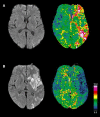Insular and caudate lesions release abnormal yawning in stroke patients
- PMID: 24337237
- PMCID: PMC4341028
- DOI: 10.1007/s00429-013-0684-6
Insular and caudate lesions release abnormal yawning in stroke patients
Abstract
Abnormal yawning is an underappreciated phenomenon in patients with ischemic stroke. We aimed at identifying frequently affected core regions in the supratentorial brain of stroke patients with abnormal yawning and contributing to the anatomical network concept of yawning control. Ten patients with acute anterior circulation stroke and ≥3 yawns/15 min without obvious cause were analyzed. The NIH stroke scale (NIHSS), Glasgow Coma Scale (GCS), symptom onset, period with abnormal yawning, blood oxygen saturation, glucose, body temperature, blood pressure, heart rate, and modified Rankin scale (mRS) were assessed for all patients. MRI lesion maps were segmented on diffusion-weighted images, spatially normalized, and the extent of overlap between the different stroke patterns was determined. Correlations between the period with abnormal yawning and the apparent diffusion coefficient (ADC) in the overlapping regions, total stroke volume, NIHSS and mRS were performed. Periods in which patients presented with episodes of abnormal yawning lasted on average for 58 h. Average GCS, NIHSS, and mRS scores were 12.6, 11.6, and 3.5, respectively. Clinical parameters were within normal limits. Ischemic brain lesions overlapped in nine out of ten patients: in seven patients in the insula and in seven in the caudate nucleus. The decrease of the ADC within the lesions correlated with the period with abnormal yawing (r = -0.76, Bonferroni-corrected p = 0.02). The stroke lesion intensity of the common overlapping regions in the insula and the caudate nucleus correlates with the period with abnormal yawning. The insula might be the long sought-after brain region for serotonin-mediated yawning.
Figures



Similar articles
-
Pathological Yawning in Patients with Acute Middle Cerebral Artery Infarction: Prognostic Significance and Association with the Infarct Location.Balkan Med J. 2019 Dec 20;37(1):24-28. doi: 10.4274/balkanmedj.galenos.2019.2019.7.49. Epub 2019 Oct 9. Balkan Med J. 2019. PMID: 31594283 Free PMC article.
-
Association of Infarct Topography and Outcome After Endovascular Thrombectomy in Patients With Acute Ischemic Stroke.Neurology. 2022 Mar 15;98(11):e1094-e1103. doi: 10.1212/WNL.0000000000200034. Epub 2022 Jan 31. Neurology. 2022. PMID: 35101908 Free PMC article.
-
Role of Acute Lesion Topography in Initial Ischemic Stroke Severity and Long-Term Functional Outcomes.Stroke. 2015 Sep;46(9):2438-44. doi: 10.1161/STROKEAHA.115.009643. Epub 2015 Jul 21. Stroke. 2015. PMID: 26199314 Free PMC article.
-
Yawning in acute anterior circulation stroke.J Neurol Neurosurg Psychiatry. 2007 Nov;78(11):1253-4. doi: 10.1136/jnnp.2006.111906. J Neurol Neurosurg Psychiatry. 2007. PMID: 17940172 Free PMC article.
-
Yawning-Its anatomy, chemistry, role, and pathological considerations.Prog Neurobiol. 2018 Feb;161:61-78. doi: 10.1016/j.pneurobio.2017.11.003. Epub 2017 Nov 29. Prog Neurobiol. 2018. PMID: 29197651 Review.
Cited by
-
The Big Yawning: Pathological Yawning as a Symptom of Neuromyelitis Optica Spectrum Disorders.Case Rep Neurol Med. 2019 Feb 24;2019:9691863. doi: 10.1155/2019/9691863. eCollection 2019. Case Rep Neurol Med. 2019. PMID: 30918729 Free PMC article.
-
Yawning and airway physiology: a scoping review and novel hypothesis.Sleep Breath. 2022 Dec;26(4):1561-1572. doi: 10.1007/s11325-022-02565-7. Epub 2022 Feb 5. Sleep Breath. 2022. PMID: 35122606 Free PMC article.
-
Abnormal yawning in stroke patients: the role of brain thermoregulation.Front Neurosci. 2014 Sep 17;8:300. doi: 10.3389/fnins.2014.00300. eCollection 2014. Front Neurosci. 2014. PMID: 25278833 Free PMC article. No abstract available.
-
Pathological Yawning in Patients with Acute Middle Cerebral Artery Infarction: Prognostic Significance and Association with the Infarct Location.Balkan Med J. 2019 Dec 20;37(1):24-28. doi: 10.4274/balkanmedj.galenos.2019.2019.7.49. Epub 2019 Oct 9. Balkan Med J. 2019. PMID: 31594283 Free PMC article.
-
CD19+ B cell depletion: a novel strategy to alleviate ischemic stroke damage.Front Immunol. 2025 Apr 17;16:1528471. doi: 10.3389/fimmu.2025.1528471. eCollection 2025. Front Immunol. 2025. PMID: 40313936 Free PMC article.
References
-
- Auer H, Feldner-Bustin G, Hermentin K, Kollegger H, Schmidbauer M. Zerebrale Zystizerkose: Ein Fallbericht. Mitt Österr Ges Tropenmed Parasitol. 1987;9:101–109.
Publication types
MeSH terms
LinkOut - more resources
Full Text Sources
Other Literature Sources
Medical

